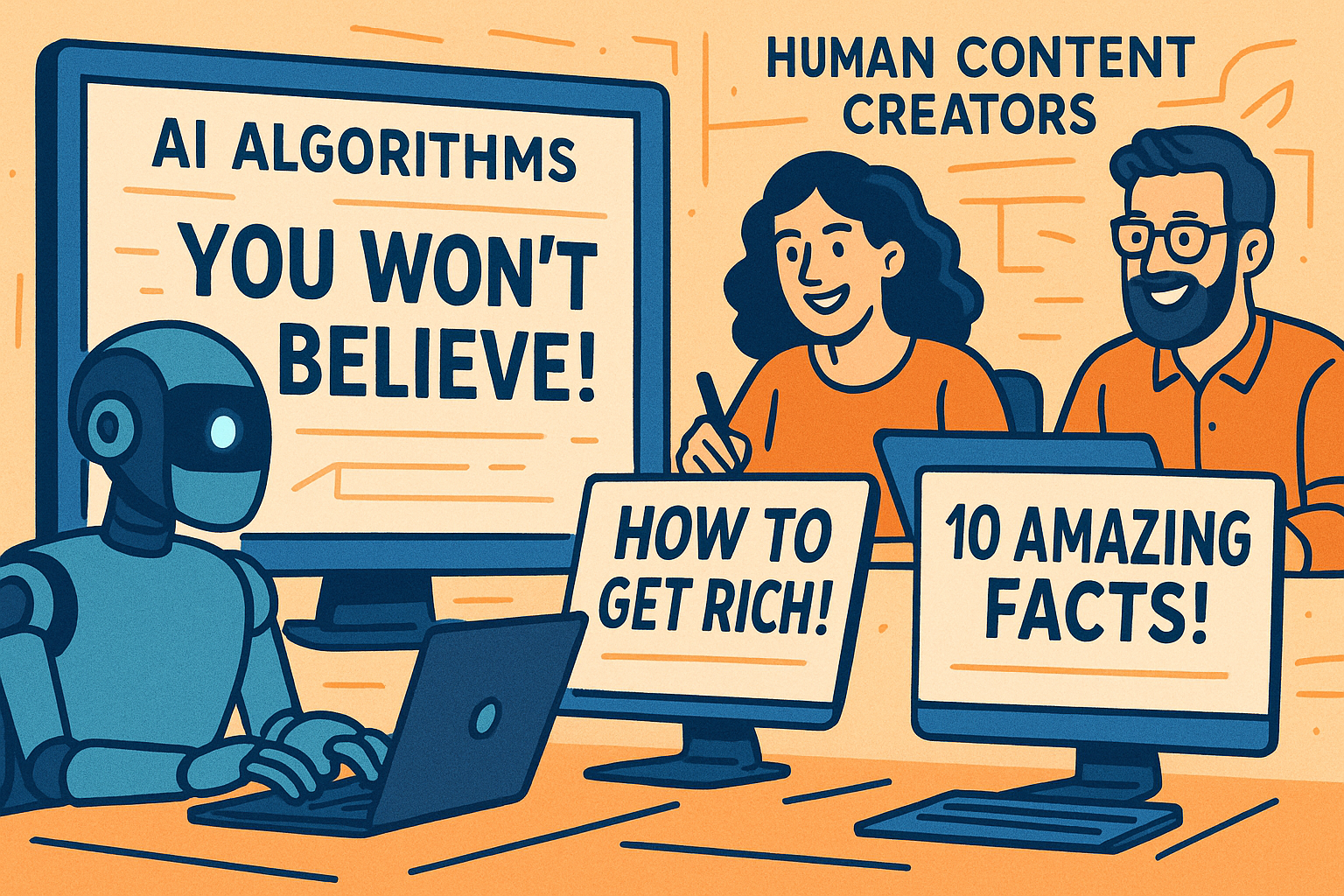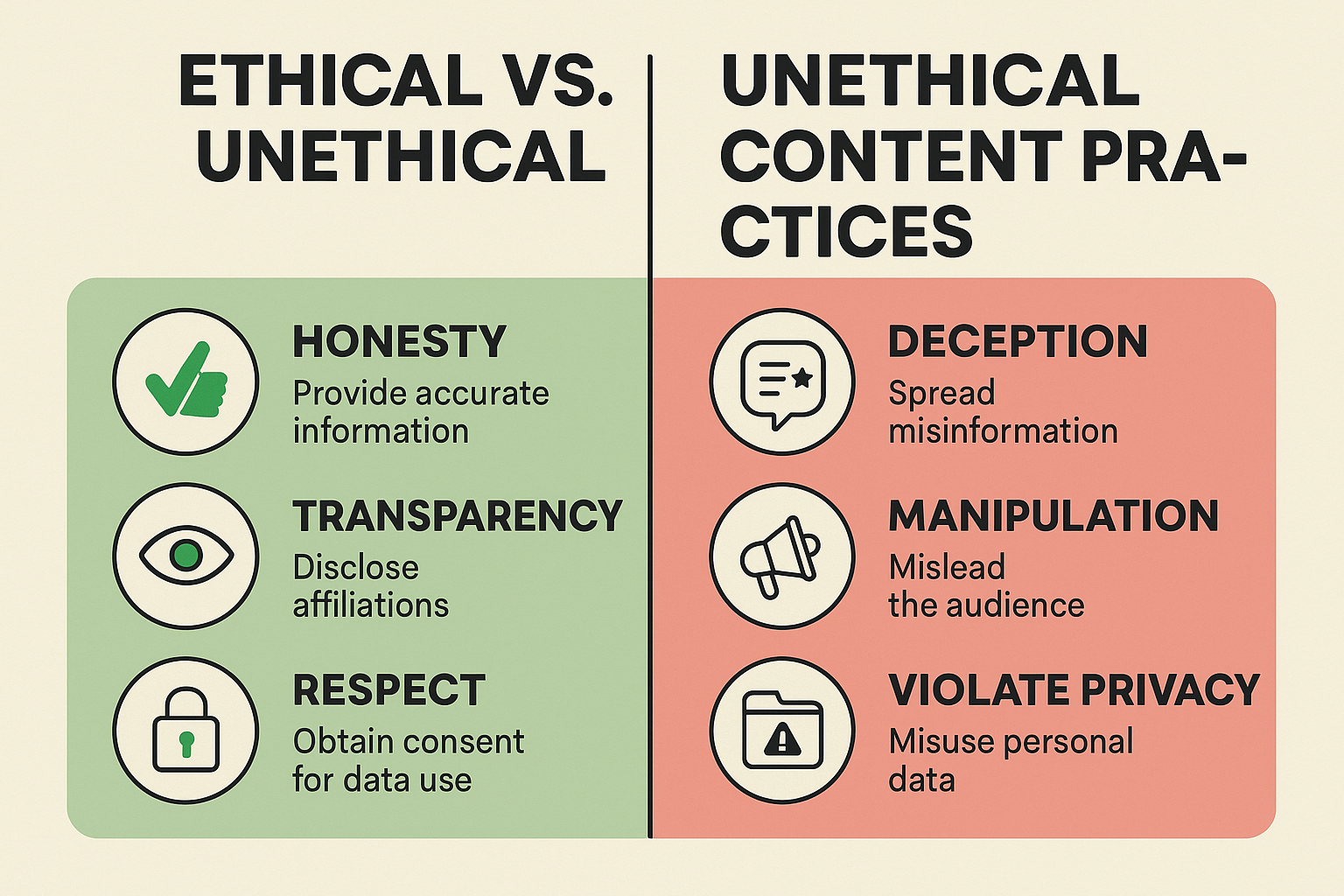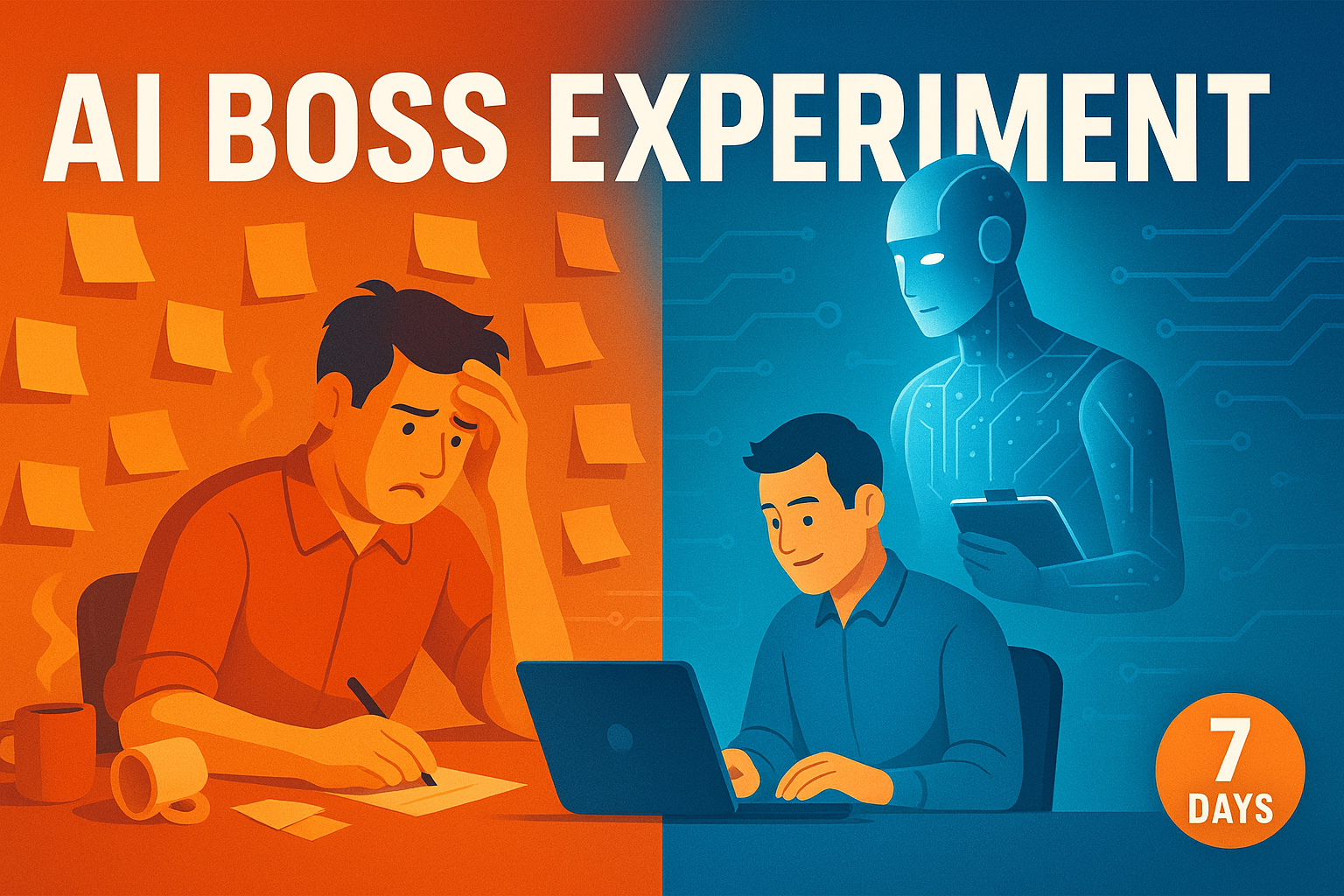
Are AIs Becoming the New Clickbait?
In a world where online attention is gold, the battle for clicks has transformed dramatically. As artificial intelligence continues to evolve, questions arise about its influence on content creation and management. Are AIs just the modern-day clickbait artists, crafting headlines that lure us in without delivering genuine value? In this article, we delve into the fascinating relationship between AI and clickbait, exploring how advanced technologies like GPT-5 shape engagement strategies, redefine digital marketing, and what it means for consumers and content creators alike.
Dev Orbit
July 27, 2025
Introduction
As digital consumers, we are inundated with a relentless wave of content vying for our attention. In this age of information overload, the rise of AI tools, specifically the latest advancements in models like GPT-5, presents a double-edged sword. On one hand, these technologies empower innovative content creation; on the other hand, they risk perpetuating a cycle of superficial engagement reminiscent of traditional clickbait. The pressing question is whether artificial intelligence is becoming the next generation of clickbait, attracting clicks with flashy headlines but ultimately leading to disillusionment. In the following sections, we will explore this phenomenon and uncover insights into how to leverage AI responsibly and ethically.
The Evolution of Clickbait: From Headlines to AI-Generated Content
Clickbait originated as a savvy tactic used by marketers and content creators to grab attention. Typically characterized by sensationalized headlines, clickbait effectively harnesses curiosity or emotion, compelling users to click. As we look into the evolution of digital content, we should consider how AI technologies have impacted this landscape.
Historical Overview: Although clickbait has been prevalent since the dawn of online media, it gained significant traction with the rise of social media platforms. They provided a fertile ground for catchy headlines to spread virally.
The Role of Algorithms: Social media and search engine algorithms favor high click-through rates. This inadvertently encouraged content creators to adopt clickbait strategies to enhance visibility.
Emergence of AI: Fast forward to today, and AI-generated content tools such as GPT-3 and its successors have emerged. These tools can create headlines, generate engaging articles, and even analyze user data to produce snippets that maximize engagement.
Human vs. AI Content Creation: The contrast between traditional content creators and AI illustrates a pivotal shift. While traditional methods focused on storytelling crafted by humans, AIs employ data-driven techniques that can sometimes result in misleading content.
The modern landscape increasingly blurs the lines between genuine engagement and clickbait strategies influenced by AI technologies. Understanding this evolution is critical to navigating the digital marketplace effectively.

The Mechanics of AI in Content Creation
As AI enters the realm of content creation, it is crucial to understand how these tools operate and the implications they carry for digital engagement.
Natural Language Processing (NLP): At the heart of AI content generation is NLP, which allows machines to understand and generate human language. This technology underpins models like GPT-5, enabling them to create coherent and contextually relevant text.
Algorithmic Recommendations: AI analyzes user behavior and preferences to tailor content that resonates with individual interests. This capability can optimize click-through rates by presenting content that feels personalized, even if it adopts clickbait-like qualities.
Predictive Analytics: By examining vast datasets, AI algorithms predict trends and user engagement patterns, offering content creators insights into what titles or topics may attract attention, ultimately steering them toward a clickbait-lite approach.
Content Authenticity: One of the keys to successful content is authenticity. However, the potential for AI to fabricate information or produce low-value content raises concerns about misleading users despite being more 'effective' in generating clicks.
The mechanics of AI content generation provide compelling advantages, but they also introduce ethical dilemmas that necessitate a careful examination of how these tools might transform or degrade the content landscape.
Real-World Examples: AIs as Clickbait Generators
The practical implications of AI's role in digital content generation become more evident when examining real-world examples. Here are a few notable cases:
News Aggregators: Many online news platforms use AI to create attention-grabbing headlines. These tools analyze user preferences, identify trending topics, and generate titles that stand out, albeit sometimes at the expense of the story's integrity.
Social Media Management: Platforms such as Hootsuite and Buffer employ AI to suggest optimized headlines and post timings based on audience engagement data. This may lead to posts that prioritize click-through rates over genuine quality.
Content Marketing Agencies: Agencies leveraging AI tools for content generation are often focused on maximizing engagement rather than enhancing informative substance. This approach can undermine quality journalism and user experience.
AI-Driven Advertising: Ad networks increasingly utilize AI technology to target specific demographics effectively. However, this can create echo chambers where content is designed to incite clicks rather than provide meaningful insights.
These examples illustrate the dual nature of AI's impact on content. While it can optimize engagement, there is a risk of sacrificing authenticity in favor of click-driven strategies.
Balancing AI Efficiency with Ethical Responsibility
As AI becomes more integrated into content creation, it's essential to seek a balance between efficiency and ethical responsibility. Here are strategies to promote ethical AI use in content:
Quality over Quantity: Prioritize the substance of the content being generated. AI may be efficient, but it should complement human creativity rather than replace the depth that comes from authentic narratives.
Transparent Use of AI: Inform users when AI tools are involved in content generation. Transparency builds trust, allowing audiences to discern between human-created and AI-generated content.
Avoid Sensationalism: Craft engaging but honest headlines. Resist the temptation to employ clickbait techniques that sacrifice truth for clicks. This way, content remains valuable and trustworthy.
Incorporate Human Editing: Always follow up AI-generated content with human review. A diverse perspective can ensure that generated content aligns with ethical standards and resonates more deeply with the audience.
By fostering responsible use of AI technologies in content creation, we can maintain a healthy online ecosystem while leveraging the benefits of advanced tools.

Bonus/Advanced Tips
For those venturing into AI-generated content, here are additional insights, tradeoffs, and best practices to optimize your strategy:
Monitor Engagement Metrics: Regularly analyze engagement data to identify the effectiveness of AI-generated content. Look for trends and patterns to refine your techniques continuously.
Experiment with Variations: Use A/B testing to evaluate different AI-generated headlines and formats. This scientific approach allows you to assess which tactics resonate of your target audience better.
Be Mindful of Over-Reliance: While AI can enhance productivity, ensure that your brand voice remains intact. Too much dependency might dilute your unique identity.
Stay Updated on AI Trends: The AI landscape is constantly evolving. Stay informed about the latest developments and features in AI content creation tools, ensuring you are utilizing them to their fullest potential.
Community Engagement: Foster a dialogue with your audience. Encourage feedback on articles or content produced with AI. This interaction can enhance trust and improve the content quality.
Legal and Ethical Considerations: Understand the legalities surrounding AI use in content creation, including copyright and intellectual property rights. Ensure compliance with all applicable regulations.
Conclusion
As we navigate the ever-evolving landscape of digital content, it is crucial to recognize the implications of AI technology on our engagement strategies. While AI tools like GPT-5 can enhance productivity and facilitate interactive engagement, we must be vigilant against the pitfalls of clickbait tactics that do not prioritize quality. By balancing efficiency with ethical responsibilities, we can leverage AI while maintaining the trust and satisfaction of our audiences. Now is the time to reflect on how we utilize these innovative tools. Share your thoughts below, engage with this content, and consider integrating these insights into your content strategy.

Enjoyed this article?
Subscribe to our newsletter and never miss out on new articles and updates.
More from Dev Orbit

Nexus Chat|与 Steve Yu 深入探讨 Nexus 生态系统
在这篇文章中,我们将深入探索 Nexus 生态系统,揭示它如何为未来的数字环境奠定基础,以及 Steve Yu 对这一范畴的深刻见解和前瞻性思考。

World Models: Machines That actually “Think”
Discover how advanced AI systems, often dubbed world models, are set to revolutionize the way machines interpret and interact with their environment. Dive deep into the underpinnings of machine cognition and explore practical applications.

🕵️♂️ Mastering Stealth Web Scraping in 2025: Proxies, Evasion and Real-World Techniques
A 2025 Guide to Evading Bot Detection with Playwright, Proxies and Human-Like Behavior

9 Powerful Reasons Why NestJS Beats Other Backend Frameworks in 2025
NestJS is revolutionizing how developers approach backend development in 2025. With built-in TypeScript support, modular architecture and first-class microservices integration, it's more than just a framework—it's a complete platform for building enterprise-grade, scalable applications. Discover why NestJS outshines Express, Django, Laravel and other backend giants in this in-depth comparison.

📌Self-Hosting Secrets: How Devs Are Cutting Costs and Gaining Control
Self-hosting is no longer just for the tech-savvy elite. In this deep-dive 2025 tutorial, we break down how and why to take back control of your infrastructure—from cost, to security, to long-term scalability.

Event-Driven Architecture in Node.js
Event Driven Architecture (EDA) has emerged as a powerful paradigm for building scalable, responsive, and loosely coupled systems. In Node.js, EDA plays a pivotal role, leveraging its asynchronous nature and event-driven capabilities to create efficient and robust applications. Let’s delve into the intricacies of Event-Driven Architecture in Node.js exploring its core concepts, benefits, and practical examples.
Releted Blogs

Top AI Tools to Skyrocket Your Team’s Productivity in 2025
As we embrace a new era of technology, the reliance on Artificial Intelligence (AI) is becoming paramount for teams aiming for high productivity. This blog will dive into the top-tier AI tools anticipated for 2025, empowering your team to automate mundane tasks, streamline workflows, and unleash their creativity. Read on to discover how these innovations can revolutionize your workplace and maximize efficiency.

You’re Using ChatGPT Wrong: Try This Underground Prompting Method Instead
Unlock the full potential of ChatGPT with innovative prompting techniques that elevate your conversations and outputs. Learn how to interact with AI like a pro by diving deep into unique and effective methods that go beyond typical usage. This post unveils the underground prompting strategies that can lead to richer, more contextual AI interactions.

AI Is Reshaping Jobs — and That Could Hit You Hard
As artificial intelligence continues to evolve, its impact on the job market is growing more profound each day. In this article, we will explore how AI technologies like GPT-5 are transforming various industries, the potential risks for workers, and actionable steps to navigate this changing landscape. From automation to the creation of new job roles, we will offer insights that every professional should be aware of to remain competitive in the era of AI.

I Replaced My To-Do List With an AI Boss — Here’s the Ruthless Truth About My Productivity
In an age where time is a precious commodity, productivity hacks abound but often lead to more confusion than clarity. What if you could replace your cumbersome to-do list with an AI assistant that not only organizes your tasks but also learns from your habits? Enter GPT-5 — an AI that transforms how we approach our daily workloads. In this article, I’ll share my journey of swapping a traditional to-do list for an AI-driven system, detailing the profound impact on my productivity.

How to Build an App Like SpicyChat AI: A Complete Video Chat Platform Guide
Are you intrigued by the concept of creating your own video chat platform like SpicyChat AI? In this comprehensive guide, we will walk you through the essentials of building a robust app that not only facilitates seamless video communication but also leverages cutting-edge technology such as artificial intelligence. By the end of this post, you'll have a clear roadmap to make your video chat application a reality, incorporating intriguing features that enhance user experience.

GitHub Copilot vs Tabnine (2025): Which AI Assistant is Best?
AI coding assistants are no longer futuristic experiments—they’re becoming essential tools in the modern developer’s workflow. In this review, we’ll compare GitHub Copilot and Tabnine head-to-head in 2025, exploring how each performs in real-world backend coding tasks. From productivity gains to code quality, we’ll answer the burning question: Which AI assistant should you trust with your code?
Have a story to tell?
Join our community of writers and share your insights with the world.
Start Writing